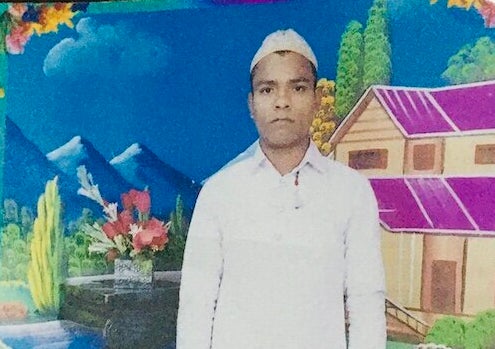
NEW DELHI — Faizan, the 23-year-old Muslim man who was filmed as he was brutally assaulted by policemen who forced him to sing the national anthem between beatings, died after the Delhi Police illegally detained him for over 36 hours and denied him urgent medical attention, HuffPost India can establish.
Since news of Faizan’s death was made public on February 28, the Delhi Police has sought to deflect responsibility by claiming they never took Faizan into custody.
HuffPost India spoke to policemen, eye-witnesses, doctors, legal volunteers and Faizan’s family members who contradicted the police account, and established that Faizan’s untimely and violent demise was a direct consequence of police actions over a three-day period from February 24, when Faizan was first assaulted, to February 26, when he finally succumbed to his many injuries at 11 pm.
“For two days, he clamoured for aid locked up inside and they did not let him go,” said Faizan’s sister Sonam who, like her brother, goes by one name.
“His body had turned blue all over when they released him,” Kismatun, Faizan’s 61-year-old mother, said. “He had stitches on his ear and on his head. The policemen had hit him, putting a baton inside his throat. He was in so much pain that he could not even gulp liquids such as water or milk when we got back home.”
Another young man, assaulted and humiliated by the police in the same incident that claimed Faizan’s life, has similar injuries but is terrified of seeking medical attention as he fears the police’s reprisal. HuffPost India is withholding his name to protect him.
The Delhi Police’s actions during last week’s communal riots, which have claimed at least 42 lives in the national capital, have come under increasing scrutiny. Much of the criticism thus far has focused on the police’s seeming inability to stop the violence. Videos of policemen assaulting civilians have been explained away as an attempt to bring the violence under control.
Now, the following sequence of events leading to Faizan’s death suggests some members of the Delhi Police actively participated in the communal riots, and bear direct responsibility for at least some of the deaths and violence that unfolded between February 23 and February 27 2020. The Delhi Police reports to the Union Home Minister Amit Shah from the Hindu-rightwing Bharatiya Janata Party (BJP). The BJP’s Minister of State for Finance Anurag Thakur, and Delhi elections candidate Kapil Mishra have been accused of giving inflammatory speeches shortly before the riots, in a petition before India’s Supreme Court. Opposition parties have demanded Shah’s resignation in light of the Delhi Police’s actions during the riots.
Deputy Commissioner of Police (North East Delhi) Ved Prakash Surya did not respond to this reporter’s phone calls and SMS requests to comment on HuffPost India’s findings. DCP Surya also did not respond to questions of whether the police would formally enquire into the circumstances around Faizan’s death.
“He was in so much pain that he could not even gulp liquids such as water or milk when we got back home.”
- Kismatun, Faizan’s 61-year-old mother
Assaulted, forced to sing national anthem
On February 24, a sit-in protest against the controversial Citizenship Amendment Act in Kardampuri, a neighbourhood in northeast Delhi, had completed its 45th day when residents say they were showered with rocks from across the road.
The stone-pelting in Kardampuri was part of a wave of riots sweeping across this part of the city. As the mostly Muslim residents occupying the road looked up, they say they saw policemen standing with a group of men who were flinging the rocks.
Faizan’s mother Kismatun, who was part of the sit-in protest, told HuffPost India that her son had reached the protest site to look for her.
At about 4 pm, said the unnamed young man cited above, men in police uniforms began violently beating him and other men, including Faizan, outside the Kardampuri mohalla clinic.
“A policeman speaking in a thick Haryanvi accent, who was not wearing a badge, forced us to sing the national anthem if we wanted Azaadi,” he said.
Azaadi, or freedom, has become a rallying cry for many protests against the CAA.
“One of the injured men could not sing it properly,” said this young man who was an eyewitness and a victim of the violence. HuffPost India is withholding his identity to protect him from further police reprisals. “The policemen started getting angrier and started screaming and shouting, saying that if we do not even know the national anthem, what “Azaadi” do we dare for?”
All this while, one of the policemen standing atop them made multiple video clips, he added.
One of these videos quickly went viral. The authenticity of the video has been confirmed by fact-checking site Alt News by comparing it with a second video of the same incident shot from a different angle.
“The policemen put a lathi in the mouth of one of those injured, choking him. They thrashed me till I was barely conscious and then dragged me on the road towards a Gypsy,” the victim said. “The skin on my left temple and eye got scraped off from the friction on the road, as they dragged us for a few metres. They were treating us as if we were beasts, not human.”
HuffPost India can confirm that this eyewitness and victim is currently bed-ridden and still bears visible injuries of his violent assault.
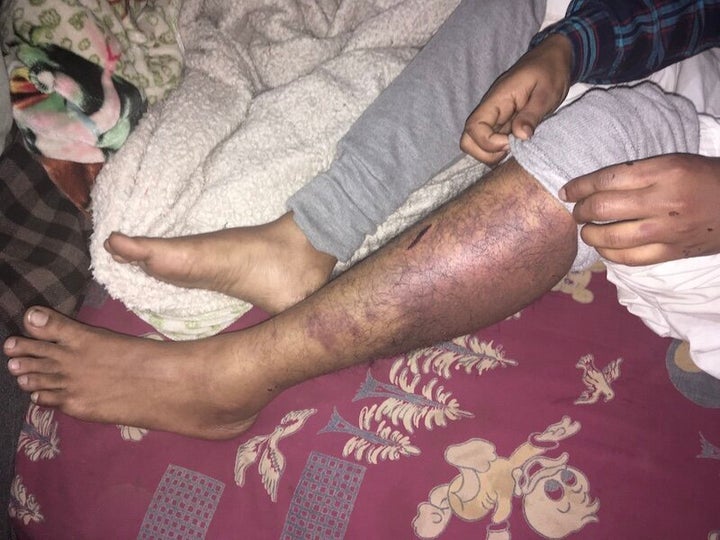
After they were assaulted in the street, the men — including Faizan, and the eyewitness who spoke to HuffPost India — were driven in a police Gypsy to Guru Teg Bahadur Hospital. A preliminary medical examination was conducted, and Faizan received stitches to his head.
HuffPost India has not been able to access a copy of Faizan’s medico-legal certificate prepared by GTB hospital, but has ascertained the certificate’s number, D-23-113844272, from Narendra Rana, Assistant Sub-Inspector of the Delhi Police, deputed at the Lok Nayak Jai Prakash Narayan Hospital. Faizan’s family told HuffPost India that the hospital was yet to give them a copy of the certificate. A medico-legal certificate, or MLC, is a legal document issued in cases where injured patients are brought to hospitals.
ALSO READ: Modi Govt Has Demoralised Delhi Police, Says IPS Officer Who Investigated Hashimpura Massacre
Once Faizan and the other men received very basic first aid, the eyewitness said, they were driven to the Jyoti Nagar police station and placed in the station’s lock up.
On the morning of the next day, February 25, Faizan and the eyewitness were kept in the same cell. The two men did not know each other from before, the eyewitness said.
HuffPost India spoke to a second eye-witness who said he was in the same cell in the Jyoti Nagar Police Station as Faizan and the first eye-witness.
“Both of them could not even walk as they had injuries all over, I had to help both of them go to the toilet on February 25,” this second eyewitness said. “Inside the lock-up, Faizan tried to drink water but he kept vomiting. He got more and more uneasy through the afternoon.”
This second eyewitness said he was not in the “national anthem video”, but he was also assaulted by the Delhi police on February 24.
“When the stone-pelting and tear gas shelling started on February 24 afternoon, I hid in a public toilet to save myself,” the second eye-witness said. “A few policemen saw me come out of the toilet and started thrashing me on the road. I was not in the national anthem video. The police put me in a bus and brought me to Jyoti Nagar where I was locked up. The next morning, Faizan and the other man were shifted into the same cell as me.”
HuffPost India is withholding the name of this second eyewitness as well to protect him from police reprisals.
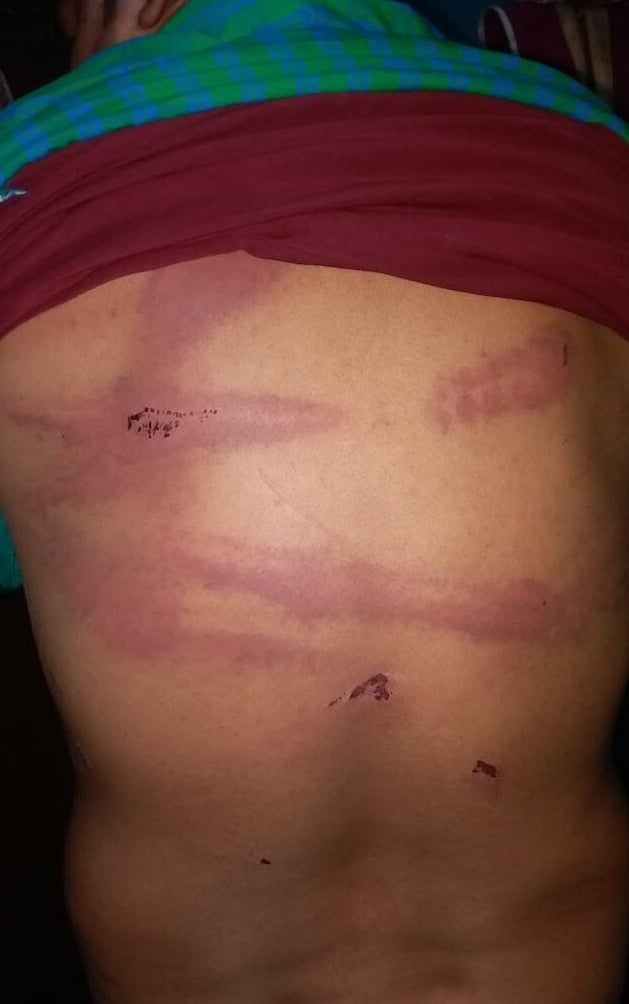
At 10:30 pm on the night of February 25, said the second eyewitness, Shailendra Tomar, the Station House Officer of the Jyoti Nagar Police Station, called out to the men and asked them their names, their father’s names and their addresses.
Tomar, the second witness subsequently learnt, had received a call from Sajid Khan, a municipal councillor from the Aam Aadmi Party.
“All three of us were handed over to our family members late at night. We returned in an auto rickshaw to Kardampuri at 1 am on February 26,” the second eyewitness said.
While the police dithered, Faizan’s condition had steadily deteriorated in the lock-up.
SHO Tomar confirmed that the men were brought to his station on February 24, but claimed they were released the same night.
“These men were culprits found rioting. They were taken to Guru Teg Bahadur hospital on the evening of February 24, and then brought to this police station, but we allowed their families to take them the same night, and none of them were held here,” Tomar told HuffPost India on Friday, February 28.
The eyewitnesses and Faizan’s family members have contradicted Tomar’s account.
‘He was in so much pain’
HuffPost India spoke to Faizan’s family and neighbours to corroborate the timeline of Faizan’s final hours, from the time he was assaulted by the police, to the moment he breathed his last.
Faizan’s 61-year-old mother Kismatun said she first learnt that her son had been picked up by the police when a neighbour spotted him at Guru Teg Bahadur Hospital on February 24.
Kismatun said she first visited the hospital that very evening, but couldn’t find Faizan. She went to the Jyoti Nagar police station on three separate occasions from the night of February 24 to the night of February 25 to look for her son. Kismatun said that the policemen confirmed her son was in their custody but refused to let her meet him.
“On February 24 night, I showed them Faizan’s photo and Jyoti Nagar station policemen agreed he was inside but they did not allow me to meet him. Another family stood there waiting for their son and they let him go,” Kismatun said. “When I asked them why were they not letting Faizan go, they told me that the other boy’s condition was so critical that he would have died inside the station but that my child is fine. I pleaded, let me see him once but they were dismissive, they asked me to leave. I stood there till 1 am.”
At 8 am on February 25, Kismatun was back at Jyoti Nagar Police Station but the police refused to listen to her. She went a third time on the afternoon of the same day, this time with an uncle of the first eye-witness, and a relative of the second eye-witness.
Kismatun said she pleaded her son’s innocence, but the police told them to leave and threatened to arrest her and her companions.
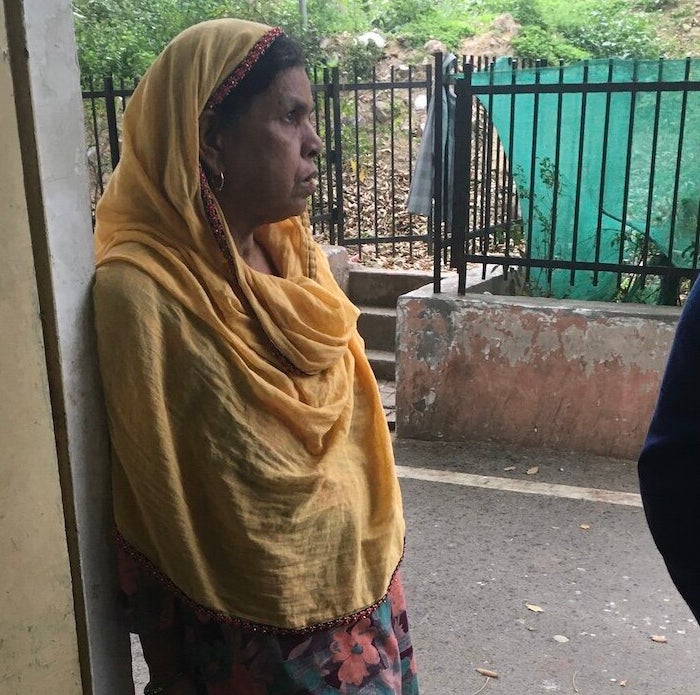
Abrar Khan, Kismatun’s neighbour, corroborated the account that Faizan and his cellmates were released only on the intervening night of February 25 and February 26 after the intervention of AAP councillor Sajid Khan.
Abrar Khan told HuffPost India that SHO Tomar called Sajid Khan at around 10.30 pm on February 25 and told the councillor to ask the families of Faizan and his cellmates to reach the Jyoti Nagar police station “to take their children back”.
“I requested Shailesh, our neighbour who drives an Ola auto rickshaw as he is a Hindu, and Shailesh took the three women relatives to Jyoti Nagar,” Abrar Khan said.
A person close to Sajid Khan confirmed that the councillor spoke with SHO Tomar about Faizan’s release on February 25.
Kismatun said the police made her put her thumbprint on a piece of paper before handing over Faizan, but did not give her a copy of that paper. Faizan and the two eyewitnesses were put into Shailesh’s auto rickshaw and brought back home to Kardampuri.
As noted earlier, Kismatun said her son’s body was already turning blue by the time the police let him go.
“He had stitches on his ear and on his head. The policemen had hit him, putting a baton inside his throat,” she said. “He was in so much pain that he could not even gulp liquids such as water or milk when we got back home at 1 am on February 26.”
By now, a day-and-a-half had elapsed since Faizan was assaulted by the police.
As Faizan’s condition continued to deteriorate, he kept sitting up and then lying down to deal with the extreme pain and discomfort he was experiencing, Kismatun said.
Passing the buck
On the morning of February 26, Kismatun took Faizan to Dr. Sherwani, a general physician who runs a clinic in Kardampuri.
Dr. Sherwani told HuffPost India that Faizan was barely responding when he examined him.
“His pulse was fading, his blood pressure had dropped. He had an open wound on his head and blood clots everywhere,” Sherwani said.
Dr Sherwani said Faizan may have suffered internal injuries and bleeding during the beatings which were not detected when the police took him to Guru Teg Bahadur Hospital.
“He was not scanned for his internal injuries at GTB, and the complications were not detected. I told the family to rush him to a public hospital and called an ambulance,” Sherwani said.
Faizan’s family rushed him to the Lok Nayak Jai Prakash Narayan Hospital by noon, but the fact that he had been initially examined at Guru Tegh Bahadur delayed his treatment. Their arrival was confirmed to HuffPost India by Dhruv S., a legal volunteer at Lok Nayak Hospital.
“The policeman deputed there said it was a medico-legal case and Faizan would not be admitted as a previous MLC existed for him at GTB hospital from Monday. This would mean he was since missing or absconding as per hospital records, he told me, even though we could see he was in no condition to even walk,” Dhruv S. said.
Assistant sub-inspector Narendra Rana, who was deputed at LNJP hospital, also told HuffPost India that Faizan could not be admitted as an MLC already existed for him at GTB hospital from February 24.
A social work volunteer then requested the Chief Casualty Officer, who helped Faizan get admitted for basic treatment. Faizan received a glucose drip in the ward at LNJP, said his mother.
“His pain increased so much that he was not able to even lie down for a few minutes to allow a whole body X-ray,” Kismatun said.
Faizan died at 11 pm the same night, on February 26. The following day, the police registered a First Information Report regarding Faizan’s death, but has refused to share a copy with his family.

After Faizan’s death, various police officers passed the buck back and forth over which police station would be responsible for the paperwork to release his body.
SHO Tomar of Jyoti Nagar said the initial incident of assault was filmed in an area under the jurisdiction of the police of Bhajanpura, an adjoining station.
Station House Officer RS Meena of Bhajanpura police station said it was the Jyoti Nagar police station police that had taken the men to GTB hospital and they were responsible. “It was an incident that they informed us about and we did not have any knowledge of it,” Meena said.
Finally, the family had to go to court on February 28. In an order on February 29, the chief metropolitan magistrate court at Karkardooma directed the Bhajanpura police station to assist in the post mortem with video filming. Investigating officer Malti Bana said the post-mortem report would be given to the family in two weeks.
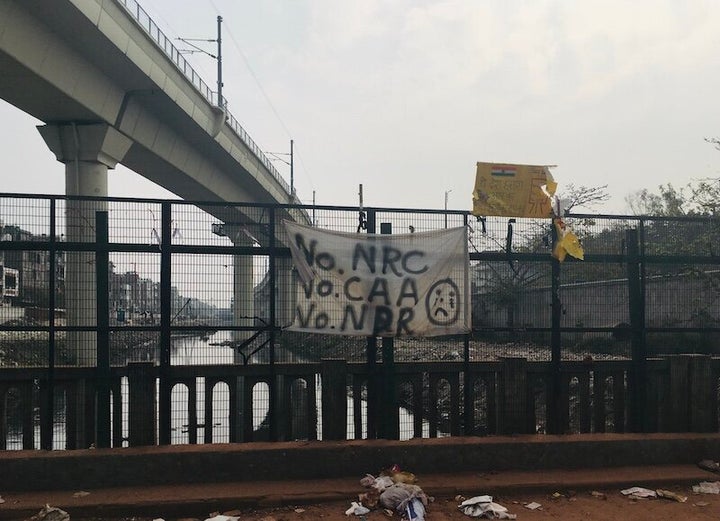
Disturbing sequence
Legal experts have questioned the Delhi Police’s actions in the Faizan case, and the seemingly arbitrary manner in which he was held at the Jyoti Nagar Police Station and then released.
“The law says you cannot keep anyone in the police station without a record. If you have called someone for questioning, such as if there is an injured person whom you suspect was involved in rioting, then you arrest them,” said Rebecca John, a senior advocate at the Supreme Court. “You cannot simply keep them in custody. Either they are a witness or an accused, there is no in-between.”
In instances where a person in detention has serious injuries, they need treatment, said John.
“The legal system and the medical system should be engineered to protect a citizen, not to kill a citizen. Here, the system has ensured a young man has died,” said John.
The fact that Faizan’s family had not been able to get any documentation from the police regarding Faizan’s detention and release was troubling, John continued, and showed the police’s culpability.
“I hope the other men who were with Faizan are able to testify that they were in custody,” John said. “It was a similar pattern in the Hashimpura riots case, where the police tried to deny the existence of the incident. But this video is very damning to the police. The new police commissioner should immediately issue orders for an enquiry.”
“The legal system and the medical system should be engineered to protect a citizen, not to kill a citizen. Here, the system has ensured a young man has died”
- Rebecca John, advocate